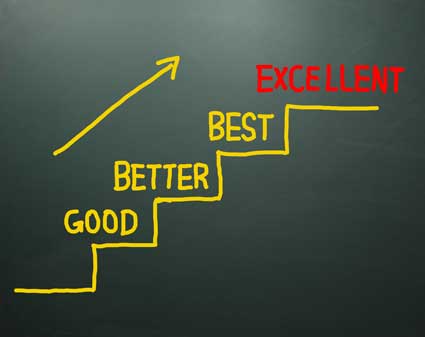It is more important now than ever before that call center managers determine and accomplish their strategic goals, as more than than 60 percent of the economy relies upon service-oriented organizations. From banks to insurance and utility companies, non-profit organizations, government agencies, and telecommunications providers, call centers have sprung up everywhere and require constant and growing maintenance. All of these companies do not have much room for pricing options and have to stay on top of their customer service, as this often becomes the differentiating factor in industries where it is easy to copy new services.
Goals First, Metrics Second
You must be able to clearly articulate your goals first in order to have any metrics, or system of gauging success, in place. You have determined your strategic and tactical goals after careful planning. What is your next step? Before executing your plan, you need to have a method of measuring your progress and success: a system of metrics. While data floods call centers, not every call center effectively plans in a way that they can measure the true metrics of how each activity adds up.
A good question to ask is, "How does each activity add value to achieving your goals?" A successful call center manager has clear tactical and strategic goals. He or she has developed a measuring stick for progress and is able to proactively use technology and other resources to optimize performance.
Quantitative and Qualitative Goals
Quantitative or numeric goals pertain to expenses, sales levels, cash flow, market share, market valuation, and profit.
Qualitative goals, on the other hand, refer to value-based progress, such as "provides world-class services" or "be a good corporate citizen." It is important that call center managers know both the bigger and detailed picture so that they can place call center goals within the broader context of the company's strategic goals.
While individual departments and strategic business units often establish action plans to achieve the broader strategic goal plan, the call center must stay in touch with both its department and the organization as a whole to set specific contact center goals and individual goals can be established. This consistency of information transfer and communication is very important in organizations, especially when they get larger as often departments lose sight of the bigger goals of the company.
There are many ways for a call center manager to stay in touch with the company's larger goals, even if they do not appear to directly affect his or her individual site immediately.
Examples include:
• reviewing the written business plan;
• reading the latest 10-K financial form filing and annual report for a publicly traded company;
• frank discussions with the vice president responsible for the contact center function.
By getting the bigger picture first, the call center manager is able to connect the smaller details within the framework of the company's larger goals. This in turn assists in validating the use of the right key performance indicators (KPIs) and methods of evaluation that are in alignment with the company's needs.
For example, in sales or collections, a call center manager might employ metrics such as:
• average revenue per contact;
• average handle time (AHT);
• debt recovered;
• first contact resolution.
Determining which of these different metrics is the most important to emphasize requires firsthand knowledge of 1) the company's larger strategic goals and 2) the call center's action plan for delivery.
Another frequent strategic goal in companies is revenue generation. How does a call center align with this goal?
There are two possible ways for a call center to generate revenue: close new business and reduce the number of customer defections.
From the perspective of the company, it is easier to reduce customer defections than it is to attract new customers. Cost savings can be as high as 10 times.
Determining the Right Metrics for Your Call Center
The saying "what gets measured gets managed" is definitely applicable to the call center industry. What are the metrics that matter? First-generation metrics measured only success by numbers. However, this did not indicate quality of the call or actual customer satisfaction. Hence, second generation metrics are necessary.
Second-generation Metrics
Second-generation metrics measure both efficiency and effectiveness. They also recognize that customers interact with the contact center through multiple channels. These metrics are derived from multiple enterprise information systems and databases.
While traditional metrics consist only of numbers, new second-generation metrics may involve insights and deeper analysis for management to better understand customer needs and behaviors.
While first-generation metrics, such as cost control and productivity improvement, are still vital to a call center's measurement of success, other second-generation metrics are now in use, especially by the proactive manager that can take your call center to the next level of performance. important today as ever.
Examples of the new secondary metrics are:
• contribution metrics;
• customer delight metrics;
Quality of Service
Quality of service is a key performance indicator. As the quality of service makes all the difference in the customer's decision of service provider, it becomes essential that your customer service representatives are able to offer quality service that attracts and retains customers. Call centers then become vital components of a company's customer strategy.
Contribution Metrics
Contribution metrics pertain specifically to how a contact center directly supports the financial goals of the company. Measuring these goals involves taking a closer look at the revenue, costs, profitability, and investments involved. These metrics are put in place to reward contact center personnel and assist management in figuring out the financial impact of the contact center.
Some examples of revenue metrics include:
• customer saves;
• customer lifetime value;
• revenue per call;
• revenue per agent;
• cross-sell attempts;
• up-sell attempts;
• average order size;
• conversion rate;
• revenue per customer;
• collections per call;
• incentive payments;
• customer retention.
In order to figure out contribution metrics, you will need both advanced technology and some brain power. Also, cross-sell and up-sell attempts can be effectively measured via speech analytics software or entered directly by the call center agent on the CRM system.
Cost and profitability metrics include:
• cost per contact per channel;
• cost per agent;
• cost per minute for voice and data communications;
• cost of service level agreements;
• agent retention rate;
• cost of recruiting a new agent;
• cost of training a new agent;
• allocation for software and hardware infrastructure;
• hourly costs (labor and benefits) for agents, quality assurance, trainers, and supervisors;
• cost of dedicated information technology (IT) support;
• annual cost of software upgrades and additions.
In addition, you must be sure to integrate the reporting systems with the information systems of other functions, such as human resources, payroll, cost accounting, and the information technology department.
Many chief financial executives of companies are now demanding a thorough financial analysis before they make any investments in call centers.
One of the most frequently used and misunderstood metrics, return on investment (ROI) is used to estimate the financial benefit of a call center investment. It is important to be able to explain what these numbers mean and, in order to do so, you must have knowledge of the costs and savings associated with investment. In fact, the call center can offer clear and accurate financial reporting of investments in new technology or other processes if these steps are taken carefully and are well-planned out.
Metrics for Change
As a call center manager, you may soon find the need for new technology, business processes, labor, and other resources. These aspects may be significant to your overall success or allow you to enhance the productivity of your center.
How do you convince your company to change or allow you to grow the center as needed?
A good example of this is the replacement of an older workforce management or WFM system that does not record well, is hard to use, and integrates poorly. Your solution involves using a voiceover Internet protocol (VoIP)-compatible architecture for performance management and automatic surveys.
Changing to the new open architecture system will require a significant capital investment. How do you do it? Via metrics. In fact, call centers have the advantage of being measured so frequently that requesting a measurement is not an issue, typically. The question then arises pertaining to your ability to get the correct data that you need. Your data must include a solid list of the monetary benefit associated with your investment and add specific numbers.
How do you show financial benefits?
Financial benefits for a call center can be demonstrated in three specific ways:
• direct cost savings;
• increased revenues;
• risk-avoidance.
How do you demonstrate direct cost savings?
The first of these, direct cost savings, can come from any number of ways, such as:
• lower labor requirements;
• using cheaper labor;
• lower administration costs;
• reduced internal IT support expenses;
• higher or more efficient utilization of telecommunication ;
• reduced analysis and reporting costs;
• faster reaction time to problems.
How do you increase revenue?
You can increase revenues by :
• increasing retention;
• having more effective up-sells and cross-sells;
• providing better service than your company's competitors.
How do you avoid risk?
Risk avoidance can be hard to quantify in numbers, but it can be done primarily through technology that assures compliance and prevents lawsuits.
Many companies today have to dish out millions of dollars just on compliance. Hence, by clearly demonstrating the value in offering compliance (which can range from 8 to 12 percent of a company's capital), you are able to clearly show the benefit of preparing your call center in advance and avoiding heavy fines and fees.
Customer Delight Metrics
What are customer delight metrics? A customer delight metric is a method of saying that your customer is highly satisfied with the company's performance, whether it is through a product or service or customer service support. This is the desired outcome of your contact center operations.
A customer who is very satisfied with quality of service is not simply loyal. This person will usually be willing to pay a premium for higher quality service. How do you measure customer delight?
Customer delight is often "inferred" by the following:
• call monitoring;
• performance against metrics that impact customer satisfaction;
• number of complaint calls.
However, such an approach fails to cover almost 96 percent of customer interactions. This data is not sufficient or relevant enough to make any true assessment.
What then is a useful metric for gauging true customer satisfaction levels?
First Contact Resolution
Only 4 percent of customers actually complain. Most just leave and go to your competitor. The metric of first contact resolution has been proved to have a direct and positive impact on customer delight.
Delight versus Satisfaction
There is a big difference between customer delight and customer satisfaction. Customer satisfaction is a modest goal because most customers today expect to be satisfied.
Customer delight, on the other hand, is about taking the relationship to another level, where the customer loves the product or service and stays longer, tells friends, and has high loyalty to the brand.
Customer delight metrics include:
• "top box," or highest level of satisfaction in customer responses;
• top box agent satisfaction;
• resolution on the first call;
• average time to answer;
• abandonment rate.
In order to have memorable customer service, work-at-home agents must have complete and up-to-date information about each caller as soon as they answer the call. By getting immediate customer feedback, managers and agents are notified immediately. They are able to see what customer experiences need improvement right away and can proactively respond to customers, thus saving them for the company.
Business Intelligence
This is one of the most popular metrics in use today. While companies spend billions on gathering business intelligence, the principal goal is to collect and interpret data generated by businesses to find better ways of doing things, using both textual and numeric data.
Information Sharing
Be sure to share information with all agents, ranging from quality problems to laws and regulations, new products, ideas, awards, and service complaints.
Examples of information to share in agent reports:
• trend charts for selected KPIs;
• summaries of revenue and profit contributions;
• competitive actions;
• campaign effectiveness;
• root causes of customer defections;
• customer satisfaction trends;
• important customer saves;
• star performers;
• status report on contact center initiatives;
• audio files of selected customer calls.
Questions you must consider include:
• Did we retain or gain any new customers?
• Did we delight our customers?
• Have we increased loyalty or retention?
• Are our operating costs on target?
• Did we gain any new insights that will help us stay ahead of the competition?
Choosing metrics that matter helps ensure you are doing what management wants. Being proactive means creating reports and making presentations that speak to the heart of the matter. This tells management that the contact center plays a pivotal role in the success of the enterprise and that you "get it."

































